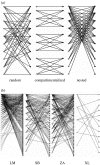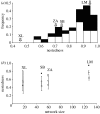Asymmetries in specialization in ant-plant mutualistic networks
- PMID: 16846911
- PMCID: PMC1635486
- DOI: 10.1098/rspb.2006.3548
Asymmetries in specialization in ant-plant mutualistic networks
Abstract
Mutualistic networks involving plants and their pollinators or frugivores have been shown recently to exhibit a particular asymmetrical organization of interactions among species called nestedness: a core of reciprocal generalists accompanied by specialist species that interact almost exclusively with generalists. This structure contrasts with compartmentalized assemblage structures that have been verified in antagonistic food webs. Here we evaluated whether nestedness is a property of another type of mutualism-the interactions between ants and extrafloral nectary-bearing plants--and whether species richness may lead to differences in degree of nestedness among biological communities. We investigated network structure in four communities in Mexico. Nested patterns in ant-plant networks were very similar to those previously reported for pollination and frugivore systems, indicating that this form of asymmetry in specialization is a common feature of mutualisms between free-living species, but not always present in species-poor systems. Other ecological factors also appeared to contribute to the nested asymmetry in specialization, because some assemblages showed more extreme asymmetry than others even when species richness was held constant. Our results support a promising approach for the development of multispecies coevolutionary theory, leading to the idea that specialization may coevolve in different but simple ways in antagonistic and mutualistic assemblages.
Figures




Similar articles
-
Interaction intimacy affects structure and coevolutionary dynamics in mutualistic networks.Curr Biol. 2007 Oct 23;17(20):1797-803. doi: 10.1016/j.cub.2007.09.059. Curr Biol. 2007. PMID: 17949981
-
The structure of ant-plant ecological networks: is abundance enough?Ecology. 2014 Feb;95(2):475-85. doi: 10.1890/12-1647.1. Ecology. 2014. PMID: 24669740
-
Changes of a mutualistic network over time: reanalysis over a 10-year period.Ecology. 2010 Mar;91(3):793-801. doi: 10.1890/08-1883.1. Ecology. 2010. PMID: 20426337
-
Ecological consequences of interactions between ants and honeydew-producing insects.Proc Biol Sci. 2007 Jan 22;274(1607):151-64. doi: 10.1098/rspb.2006.3701. Proc Biol Sci. 2007. PMID: 17148245 Free PMC article. Review.
-
Studying the Complex Communities of Ants and Their Symbionts Using Ecological Network Analysis.Annu Rev Entomol. 2016;61:353-71. doi: 10.1146/annurev-ento-010715-023719. Annu Rev Entomol. 2016. PMID: 26982442 Review.
Cited by
-
Mycelial carton galleries of Azteca brevis (Formicidae) as a multi-species network.Proc Biol Sci. 2009 Sep 22;276(1671):3265-73. doi: 10.1098/rspb.2009.0768. Epub 2009 Jun 25. Proc Biol Sci. 2009. PMID: 19556257 Free PMC article.
-
An ant's-eye view of an ant-plant protection mutualism.Oecologia. 2013 Jul;172(3):779-90. doi: 10.1007/s00442-012-2528-0. Epub 2013 Mar 21. Oecologia. 2013. PMID: 23515612 Free PMC article.
-
The human touch: a meta-analysis of anthropogenic effects on plant-pollinator interaction networks.PeerJ. 2024 Jun 27;12:e17647. doi: 10.7717/peerj.17647. eCollection 2024. PeerJ. 2024. PMID: 38948210 Free PMC article. Review.
-
Ant-plant interaction in a tropical savanna: may the network structure vary over time and influence on the outcomes of associations?PLoS One. 2014 Aug 20;9(8):e105574. doi: 10.1371/journal.pone.0105574. eCollection 2014. PLoS One. 2014. PMID: 25141007 Free PMC article.
-
Individual-based ant-plant networks: diurnal-nocturnal structure and species-area relationship.PLoS One. 2014 Jun 11;9(6):e99838. doi: 10.1371/journal.pone.0099838. eCollection 2014. PLoS One. 2014. PMID: 24918750 Free PMC article.
References
-
- Albert R, Barabasi A.L. Statistical mechanics of complex networks. Rev. Mod. Phys. 2002;74:47–97. 10.1103/RevModPhys.74.47 - DOI
-
- Anderson B, Olivieri I, Lourmas M, Stewart B.A. Comparative population genetic structures and local adaptation of two mutualists. Evolution. 2004;58:1730–1747. - PubMed
-
- Atmar W, Patterson B.D. The measure of order and disorder in the distribution of species in fragmented habitat. Oecologia. 1993;96:373–382. 10.1007/BF00317508 - DOI - PubMed
-
- Bascompte J, Jordano P. The structure of plant–animal mutualistic networks. In: Pascual M, Dunne J.A, editors. Food webs as complex adaptive networks: linking structure to dynamics. Oxford University Press; Oxford, UK: 2006. pp. 143–159.
-
- Bascompte J, Jordano P, Melián C.J, Olesen J.M. The nested assembly of plant–animal mutualistic networks. Proc. Natl Acad. Sci. USA. 2003;100:9383–9387. 10.1073/pnas.1633576100 - DOI - PMC - PubMed
Publication types
MeSH terms
LinkOut - more resources
Full Text Sources
Molecular Biology Databases

